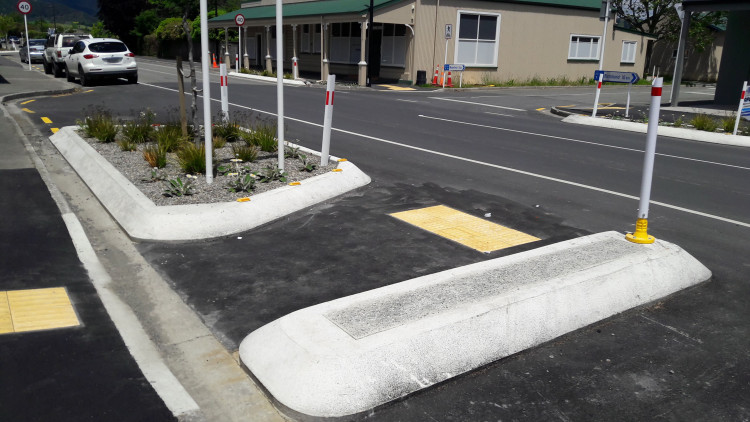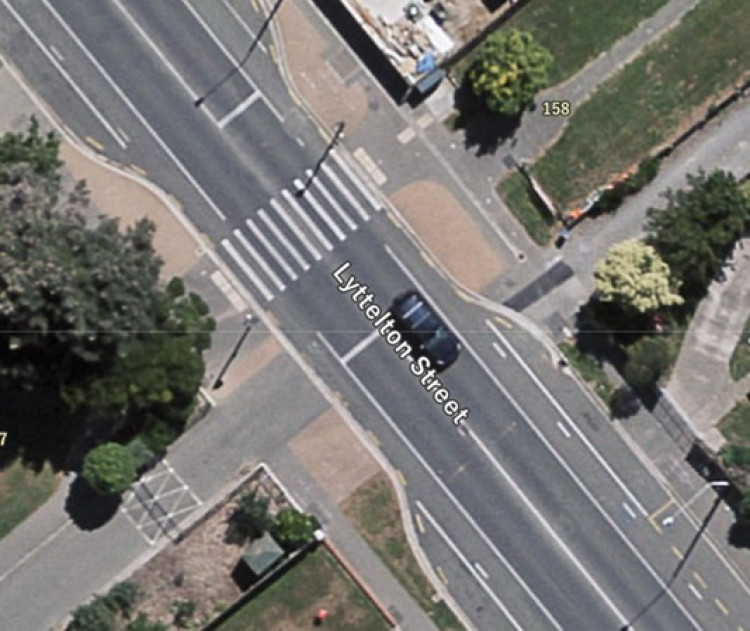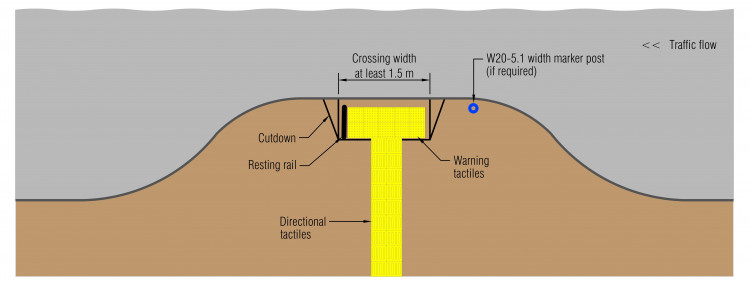Kerb extensions are a localised widening of the footpath at intersections or mid-block, which extend the footpath into and across parking lanes or the road shoulder to the edge of the traffic lane. Kerb extensions are also known as buildouts, outstands or blisters. They reduce the crossing distance for pedestrians. Examples of kerb extensions are shown below.

Retrofit kerb extension, Brightwater. (Photo: Jeanette Ward)

Kerb extensions to support a zebra crossing, Christchurch. (Source: Canterbury maps)
Check whether a kerb extension is a suitable treatment for your site by referring to:
PNG: Crossing selection process
Kerb extensions should also be considered to support other crossing types to minimise the crossing distance.
The Crossing aids and pedestrian delay section discusses the effect of kerb extensions on pedestrian delay compared with other treatments.
PNG: Crossing aids and pedestrian delay
Kerb extensions on their own are most beneficial on roads with flows less than 500 vehicles per hour. They should also be used to support
Do not use where any part of the kerb extension would protrude into a lane used by moving traffic or leave insufficient space for safe cycling.
An RCA may provide a kerb extension to guide a pedestrian to a place at which to cross a roadway (TCD Rule, 8.8(4)) and the device must convey a clear and consistent message to road users (TCD Rule, 8.8(5)).
On its own, a kerb extension does not require a driver to stop their vehicle while a pedestrian crosses the roadway (TCD Rule, 8.1(2)).
Land Transport Rule: Traffic Control Devices 2004
Access to the crossing point on the kerb extension should be provided by kerb crossings installed partly or wholly within the kerb extensions. It is important to ensure sufficient width for cyclists past the kerb extension. Landscaping and street furniture must not obscure visibility for pedestrians or drivers, particularly on the upstream side, at any time of the year. A kerb extension can be co-located at a residential driveway to minimise on-street parking loss. Consider whether on-street parking spaces should be marked, and/or no stopping lines included around the kerb extensions to ensure vehicle parking occurs away from the crossing aid.
Kerb extensions should comply with the general dimensions in the table and figure below.
Table: Kerb extension design elements
|
Element |
Requirement |
Additional information |
|
Extension depth |
0m to 7m, typically 2m to 4m |
Ensure the depth does not create a pinchpoint for cyclists by providing adequate lane widths. Further information on lane widths with and without cycle lanes is provided in the Cycling Network Guidance and here. |
|
Extension length |
At least 3m |
The length should be based on the potential number of pedestrians waiting to cross, so it is also affected by the extension depth. |
|
Approach length |
2m to 5m |
|
|
Departure length |
2m to 8m |
|
|
Curve radii |
0.5m to 6.5m, typically above 5m (concave) |
Above 5m facilitates mechanical street sweeping. |
|
0.5 to 5m, typically above 2m (convex) |
||
|
Lighting |
In accordance with AS/NZS 1158.3.1: 2020[2] |
Further information is provided in |
|
Signs and roadway markings |
Width markers on upstream approaches |
It is advisable to paint the kerbs with white or reflective paint. Parking controls and no stopping markings may be required. |
|
Tactile indicators |
Warning indicators required. Directional indicators required unless crossing is on the accessible path of travel |
Further information is provided in |
|
Over-dimension routes |
Provide a clear width of at least 10m |
Further information is provided in |

Example of a mid-block kerb extension. (TCD Manual Part 5 Figure 7‑1)
Note the curve radius of the figure above is dimensioned so street sweeper trucks are able to clean the kerb and channel.
[1] Corben, B. (2020). Integrating Safe System with Movement and Place for Vulnerable Road Users(external link), Austroads, AP-R611-20, p19
[2] AS/NZS 1158.3.1:2020(external link) Lighting for roads and public spaces Part 3.1: Pedestrian area (Category P) lighting – Performance and design requirements